Management Accounting: Applications, Analysis, and Strategy
VerifiedAdded on 2022/01/18
|47
|17542
|42
Report
AI Summary
This report provides a comprehensive overview of management accounting, encompassing its core principles, systems, and practical applications. It begins by defining management accounting and differentiating it from financial accounting, highlighting its focus on internal decision-making. The report explores the functions of management accounting, including planning, decision-making, monitoring, control, and accountability. It details the roles of both internal and external users of management accounting information, emphasizing the importance of tailored reporting. The report then delves into various management accounting systems, such as cost accounting and integrated accounting systems, and the principles that underpin them. It also covers budgetary control, planning tools, and pricing strategies. Furthermore, the report examines the application of these concepts within Tata Motors, including the use of SWOT and PEST analyses, and addresses how management accounting systems respond to financial problems, emphasizing the importance of sustainable success through effective planning and financial management.
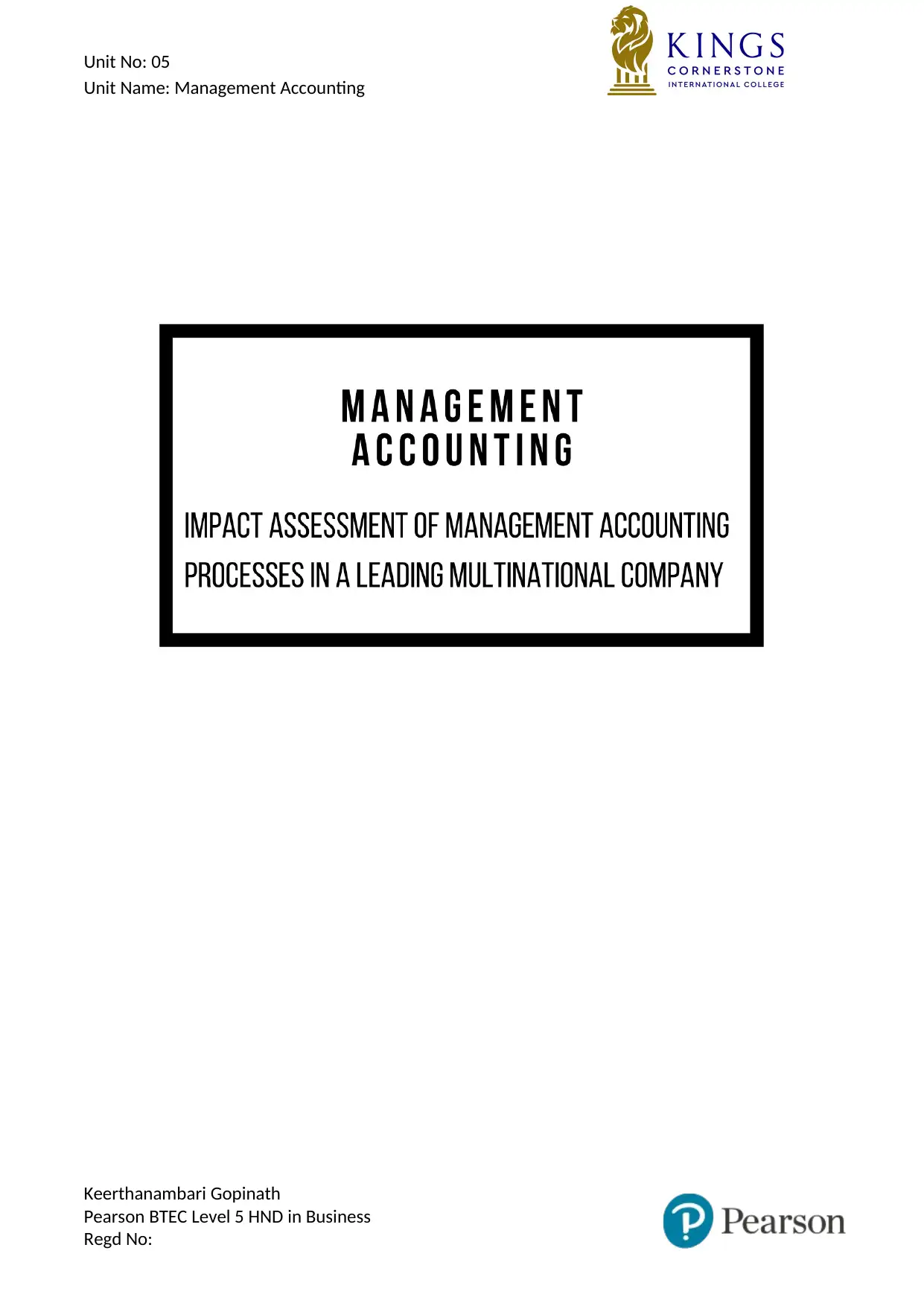
Unit No: 05
Unit Name: Management Accounting
Keerthanambari Gopinath
Pearson BTEC Level 5 HND in Business
Regd No:
Unit Name: Management Accounting
Keerthanambari Gopinath
Pearson BTEC Level 5 HND in Business
Regd No:
Paraphrase This Document
Need a fresh take? Get an instant paraphrase of this document with our AI Paraphraser
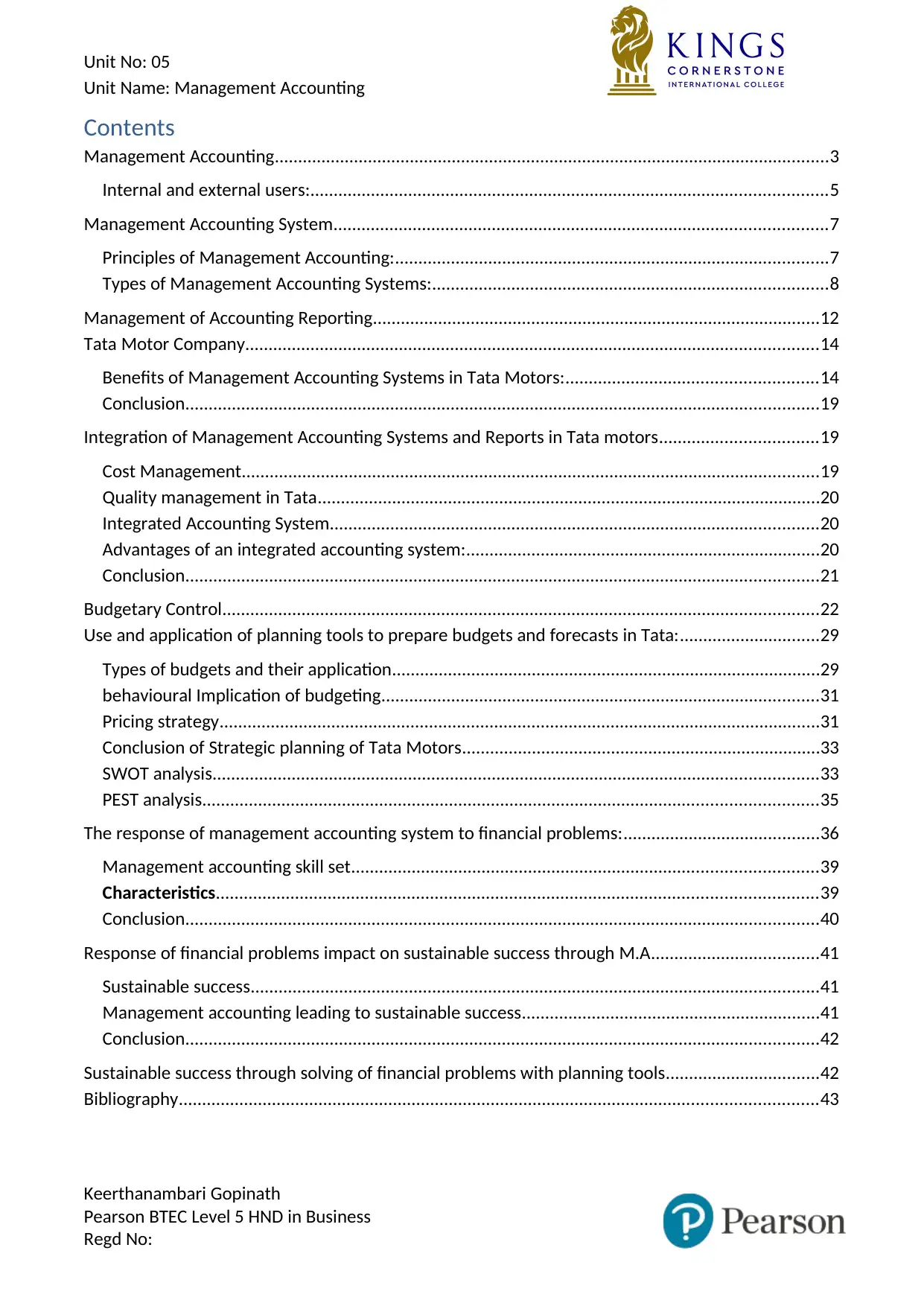
Unit No: 05
Unit Name: Management Accounting
Contents
Management Accounting.......................................................................................................................3
Internal and external users:...............................................................................................................5
Management Accounting System..........................................................................................................7
Principles of Management Accounting:.............................................................................................7
Types of Management Accounting Systems:.....................................................................................8
Management of Accounting Reporting................................................................................................12
Tata Motor Company...........................................................................................................................14
Benefits of Management Accounting Systems in Tata Motors:......................................................14
Conclusion........................................................................................................................................19
Integration of Management Accounting Systems and Reports in Tata motors..................................19
Cost Management............................................................................................................................19
Quality management in Tata............................................................................................................20
Integrated Accounting System.........................................................................................................20
Advantages of an integrated accounting system:............................................................................20
Conclusion........................................................................................................................................21
Budgetary Control................................................................................................................................22
Use and application of planning tools to prepare budgets and forecasts in Tata:..............................29
Types of budgets and their application............................................................................................29
behavioural Implication of budgeting..............................................................................................31
Pricing strategy.................................................................................................................................31
Conclusion of Strategic planning of Tata Motors.............................................................................33
SWOT analysis..................................................................................................................................33
PEST analysis....................................................................................................................................35
The response of management accounting system to financial problems:..........................................36
Management accounting skill set....................................................................................................39
Characteristics.................................................................................................................................39
Conclusion........................................................................................................................................40
Response of financial problems impact on sustainable success through M.A....................................41
Sustainable success..........................................................................................................................41
Management accounting leading to sustainable success................................................................41
Conclusion........................................................................................................................................42
Sustainable success through solving of financial problems with planning tools.................................42
Bibliography.........................................................................................................................................43
Keerthanambari Gopinath
Pearson BTEC Level 5 HND in Business
Regd No:
Unit Name: Management Accounting
Contents
Management Accounting.......................................................................................................................3
Internal and external users:...............................................................................................................5
Management Accounting System..........................................................................................................7
Principles of Management Accounting:.............................................................................................7
Types of Management Accounting Systems:.....................................................................................8
Management of Accounting Reporting................................................................................................12
Tata Motor Company...........................................................................................................................14
Benefits of Management Accounting Systems in Tata Motors:......................................................14
Conclusion........................................................................................................................................19
Integration of Management Accounting Systems and Reports in Tata motors..................................19
Cost Management............................................................................................................................19
Quality management in Tata............................................................................................................20
Integrated Accounting System.........................................................................................................20
Advantages of an integrated accounting system:............................................................................20
Conclusion........................................................................................................................................21
Budgetary Control................................................................................................................................22
Use and application of planning tools to prepare budgets and forecasts in Tata:..............................29
Types of budgets and their application............................................................................................29
behavioural Implication of budgeting..............................................................................................31
Pricing strategy.................................................................................................................................31
Conclusion of Strategic planning of Tata Motors.............................................................................33
SWOT analysis..................................................................................................................................33
PEST analysis....................................................................................................................................35
The response of management accounting system to financial problems:..........................................36
Management accounting skill set....................................................................................................39
Characteristics.................................................................................................................................39
Conclusion........................................................................................................................................40
Response of financial problems impact on sustainable success through M.A....................................41
Sustainable success..........................................................................................................................41
Management accounting leading to sustainable success................................................................41
Conclusion........................................................................................................................................42
Sustainable success through solving of financial problems with planning tools.................................42
Bibliography.........................................................................................................................................43
Keerthanambari Gopinath
Pearson BTEC Level 5 HND in Business
Regd No:
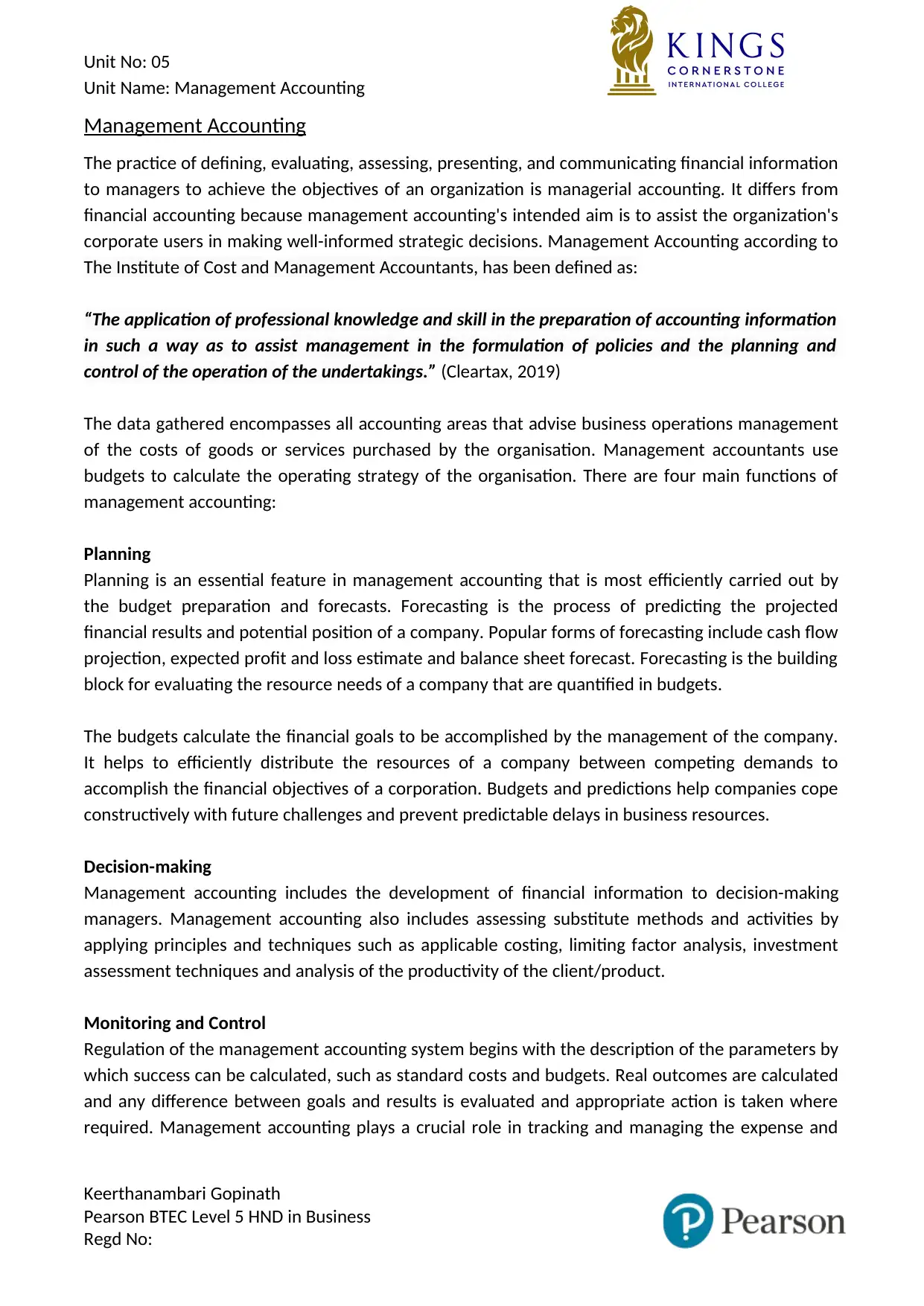
Unit No: 05
Unit Name: Management Accounting
Management Accounting
The practice of defining, evaluating, assessing, presenting, and communicating financial information
to managers to achieve the objectives of an organization is managerial accounting. It differs from
financial accounting because management accounting's intended aim is to assist the organization's
corporate users in making well-informed strategic decisions. Management Accounting according to
The Institute of Cost and Management Accountants, has been defined as:
“The application of professional knowledge and skill in the preparation of accounting information
in such a way as to assist management in the formulation of policies and the planning and
control of the operation of the undertakings.” (Cleartax, 2019)
The data gathered encompasses all accounting areas that advise business operations management
of the costs of goods or services purchased by the organisation. Management accountants use
budgets to calculate the operating strategy of the organisation. There are four main functions of
management accounting:
Planning
Planning is an essential feature in management accounting that is most efficiently carried out by
the budget preparation and forecasts. Forecasting is the process of predicting the projected
financial results and potential position of a company. Popular forms of forecasting include cash flow
projection, expected profit and loss estimate and balance sheet forecast. Forecasting is the building
block for evaluating the resource needs of a company that are quantified in budgets.
The budgets calculate the financial goals to be accomplished by the management of the company.
It helps to efficiently distribute the resources of a company between competing demands to
accomplish the financial objectives of a corporation. Budgets and predictions help companies cope
constructively with future challenges and prevent predictable delays in business resources.
Decision-making
Management accounting includes the development of financial information to decision-making
managers. Management accounting also includes assessing substitute methods and activities by
applying principles and techniques such as applicable costing, limiting factor analysis, investment
assessment techniques and analysis of the productivity of the client/product.
Monitoring and Control
Regulation of the management accounting system begins with the description of the parameters by
which success can be calculated, such as standard costs and budgets. Real outcomes are calculated
and any difference between goals and results is evaluated and appropriate action is taken where
required. Management accounting plays a crucial role in tracking and managing the expense and
Keerthanambari Gopinath
Pearson BTEC Level 5 HND in Business
Regd No:
Unit Name: Management Accounting
Management Accounting
The practice of defining, evaluating, assessing, presenting, and communicating financial information
to managers to achieve the objectives of an organization is managerial accounting. It differs from
financial accounting because management accounting's intended aim is to assist the organization's
corporate users in making well-informed strategic decisions. Management Accounting according to
The Institute of Cost and Management Accountants, has been defined as:
“The application of professional knowledge and skill in the preparation of accounting information
in such a way as to assist management in the formulation of policies and the planning and
control of the operation of the undertakings.” (Cleartax, 2019)
The data gathered encompasses all accounting areas that advise business operations management
of the costs of goods or services purchased by the organisation. Management accountants use
budgets to calculate the operating strategy of the organisation. There are four main functions of
management accounting:
Planning
Planning is an essential feature in management accounting that is most efficiently carried out by
the budget preparation and forecasts. Forecasting is the process of predicting the projected
financial results and potential position of a company. Popular forms of forecasting include cash flow
projection, expected profit and loss estimate and balance sheet forecast. Forecasting is the building
block for evaluating the resource needs of a company that are quantified in budgets.
The budgets calculate the financial goals to be accomplished by the management of the company.
It helps to efficiently distribute the resources of a company between competing demands to
accomplish the financial objectives of a corporation. Budgets and predictions help companies cope
constructively with future challenges and prevent predictable delays in business resources.
Decision-making
Management accounting includes the development of financial information to decision-making
managers. Management accounting also includes assessing substitute methods and activities by
applying principles and techniques such as applicable costing, limiting factor analysis, investment
assessment techniques and analysis of the productivity of the client/product.
Monitoring and Control
Regulation of the management accounting system begins with the description of the parameters by
which success can be calculated, such as standard costs and budgets. Real outcomes are calculated
and any difference between goals and results is evaluated and appropriate action is taken where
required. Management accounting plays a crucial role in tracking and managing the expense and
Keerthanambari Gopinath
Pearson BTEC Level 5 HND in Business
Regd No:
⊘ This is a preview!⊘
Do you want full access?
Subscribe today to unlock all pages.

Trusted by 1+ million students worldwide
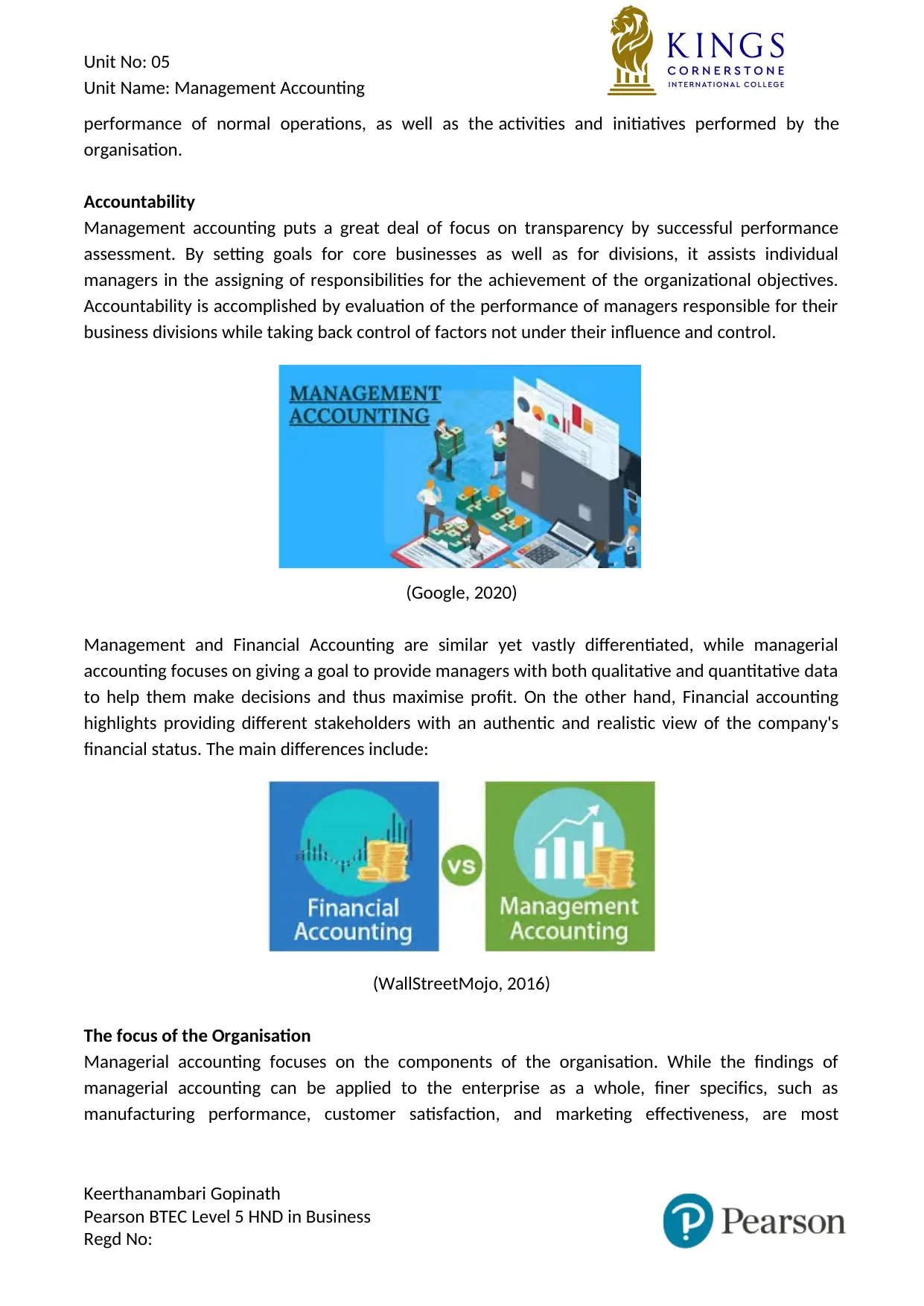
Unit No: 05
Unit Name: Management Accounting
performance of normal operations, as well as the activities and initiatives performed by the
organisation.
Accountability
Management accounting puts a great deal of focus on transparency by successful performance
assessment. By setting goals for core businesses as well as for divisions, it assists individual
managers in the assigning of responsibilities for the achievement of the organizational objectives.
Accountability is accomplished by evaluation of the performance of managers responsible for their
business divisions while taking back control of factors not under their influence and control.
(Google, 2020)
Management and Financial Accounting are similar yet vastly differentiated, while managerial
accounting focuses on giving a goal to provide managers with both qualitative and quantitative data
to help them make decisions and thus maximise profit. On the other hand, Financial accounting
highlights providing different stakeholders with an authentic and realistic view of the company's
financial status. The main differences include:
(WallStreetMojo, 2016)
The focus of the Organisation
Managerial accounting focuses on the components of the organisation. While the findings of
managerial accounting can be applied to the enterprise as a whole, finer specifics, such as
manufacturing performance, customer satisfaction, and marketing effectiveness, are most
Keerthanambari Gopinath
Pearson BTEC Level 5 HND in Business
Regd No:
Unit Name: Management Accounting
performance of normal operations, as well as the activities and initiatives performed by the
organisation.
Accountability
Management accounting puts a great deal of focus on transparency by successful performance
assessment. By setting goals for core businesses as well as for divisions, it assists individual
managers in the assigning of responsibilities for the achievement of the organizational objectives.
Accountability is accomplished by evaluation of the performance of managers responsible for their
business divisions while taking back control of factors not under their influence and control.
(Google, 2020)
Management and Financial Accounting are similar yet vastly differentiated, while managerial
accounting focuses on giving a goal to provide managers with both qualitative and quantitative data
to help them make decisions and thus maximise profit. On the other hand, Financial accounting
highlights providing different stakeholders with an authentic and realistic view of the company's
financial status. The main differences include:
(WallStreetMojo, 2016)
The focus of the Organisation
Managerial accounting focuses on the components of the organisation. While the findings of
managerial accounting can be applied to the enterprise as a whole, finer specifics, such as
manufacturing performance, customer satisfaction, and marketing effectiveness, are most
Keerthanambari Gopinath
Pearson BTEC Level 5 HND in Business
Regd No:
Paraphrase This Document
Need a fresh take? Get an instant paraphrase of this document with our AI Paraphraser
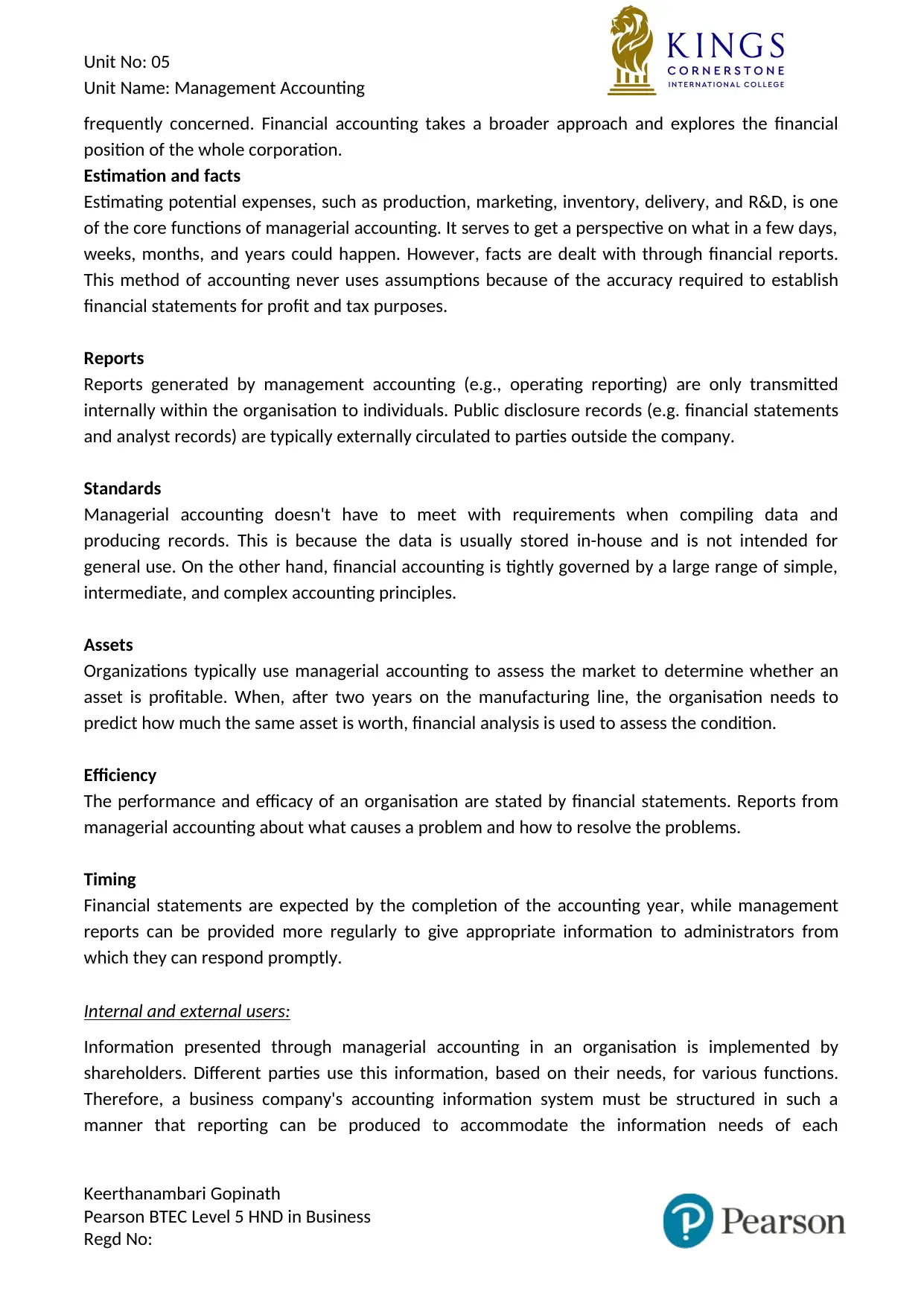
Unit No: 05
Unit Name: Management Accounting
frequently concerned. Financial accounting takes a broader approach and explores the financial
position of the whole corporation.
Estimation and facts
Estimating potential expenses, such as production, marketing, inventory, delivery, and R&D, is one
of the core functions of managerial accounting. It serves to get a perspective on what in a few days,
weeks, months, and years could happen. However, facts are dealt with through financial reports.
This method of accounting never uses assumptions because of the accuracy required to establish
financial statements for profit and tax purposes.
Reports
Reports generated by management accounting (e.g., operating reporting) are only transmitted
internally within the organisation to individuals. Public disclosure records (e.g. financial statements
and analyst records) are typically externally circulated to parties outside the company.
Standards
Managerial accounting doesn't have to meet with requirements when compiling data and
producing records. This is because the data is usually stored in-house and is not intended for
general use. On the other hand, financial accounting is tightly governed by a large range of simple,
intermediate, and complex accounting principles.
Assets
Organizations typically use managerial accounting to assess the market to determine whether an
asset is profitable. When, after two years on the manufacturing line, the organisation needs to
predict how much the same asset is worth, financial analysis is used to assess the condition.
Efficiency
The performance and efficacy of an organisation are stated by financial statements. Reports from
managerial accounting about what causes a problem and how to resolve the problems.
Timing
Financial statements are expected by the completion of the accounting year, while management
reports can be provided more regularly to give appropriate information to administrators from
which they can respond promptly.
Internal and external users:
Information presented through managerial accounting in an organisation is implemented by
shareholders. Different parties use this information, based on their needs, for various functions.
Therefore, a business company's accounting information system must be structured in such a
manner that reporting can be produced to accommodate the information needs of each
Keerthanambari Gopinath
Pearson BTEC Level 5 HND in Business
Regd No:
Unit Name: Management Accounting
frequently concerned. Financial accounting takes a broader approach and explores the financial
position of the whole corporation.
Estimation and facts
Estimating potential expenses, such as production, marketing, inventory, delivery, and R&D, is one
of the core functions of managerial accounting. It serves to get a perspective on what in a few days,
weeks, months, and years could happen. However, facts are dealt with through financial reports.
This method of accounting never uses assumptions because of the accuracy required to establish
financial statements for profit and tax purposes.
Reports
Reports generated by management accounting (e.g., operating reporting) are only transmitted
internally within the organisation to individuals. Public disclosure records (e.g. financial statements
and analyst records) are typically externally circulated to parties outside the company.
Standards
Managerial accounting doesn't have to meet with requirements when compiling data and
producing records. This is because the data is usually stored in-house and is not intended for
general use. On the other hand, financial accounting is tightly governed by a large range of simple,
intermediate, and complex accounting principles.
Assets
Organizations typically use managerial accounting to assess the market to determine whether an
asset is profitable. When, after two years on the manufacturing line, the organisation needs to
predict how much the same asset is worth, financial analysis is used to assess the condition.
Efficiency
The performance and efficacy of an organisation are stated by financial statements. Reports from
managerial accounting about what causes a problem and how to resolve the problems.
Timing
Financial statements are expected by the completion of the accounting year, while management
reports can be provided more regularly to give appropriate information to administrators from
which they can respond promptly.
Internal and external users:
Information presented through managerial accounting in an organisation is implemented by
shareholders. Different parties use this information, based on their needs, for various functions.
Therefore, a business company's accounting information system must be structured in such a
manner that reporting can be produced to accommodate the information needs of each
Keerthanambari Gopinath
Pearson BTEC Level 5 HND in Business
Regd No:

Unit No: 05
Unit Name: Management Accounting
stakeholder. There are typically types of primary users of the accounting information: (SlideShare,
2017)
(Google, 2018)
1. Internal users
Managers
Management uses accounting reports to analyse and evaluate the operating performance and
status of the company, to make crucial decisions and necessary measures to increase the revenue,
financial situation and profitability of firm performance. Setting rules and policies to meet
corporate goals is among the main management functions. Management uses knowledge created
by the organisation's economic and managerial accounting system for this purpose.
Executives
To initiate and manage companies, owners spend money with the primary goal of generating profit.
To understand what they have gained or incurred over a given period, they enable effective
financial records. They determine their strategic direction of business decisions based on this
knowledge. Owners often play the role of management in small enterprises, such as sole
proprietorship or partnership.
2. External users
Suppliers
Suppliers are large corporations or businesses who typically supply goods or materials on loan to
other firms. They use accounting statistics to provide an understanding of the company's potential
credit quality and to determine whether or not it should continue to supply credit products.
Customers
Accounting information provides consumers with valuable information on a corporate
organisation's current status and to decide on the prospects. Manufacturers or vendors require
Keerthanambari Gopinath
Pearson BTEC Level 5 HND in Business
Regd No:
Unit Name: Management Accounting
stakeholder. There are typically types of primary users of the accounting information: (SlideShare,
2017)
(Google, 2018)
1. Internal users
Managers
Management uses accounting reports to analyse and evaluate the operating performance and
status of the company, to make crucial decisions and necessary measures to increase the revenue,
financial situation and profitability of firm performance. Setting rules and policies to meet
corporate goals is among the main management functions. Management uses knowledge created
by the organisation's economic and managerial accounting system for this purpose.
Executives
To initiate and manage companies, owners spend money with the primary goal of generating profit.
To understand what they have gained or incurred over a given period, they enable effective
financial records. They determine their strategic direction of business decisions based on this
knowledge. Owners often play the role of management in small enterprises, such as sole
proprietorship or partnership.
2. External users
Suppliers
Suppliers are large corporations or businesses who typically supply goods or materials on loan to
other firms. They use accounting statistics to provide an understanding of the company's potential
credit quality and to determine whether or not it should continue to supply credit products.
Customers
Accounting information provides consumers with valuable information on a corporate
organisation's current status and to decide on the prospects. Manufacturers or vendors require
Keerthanambari Gopinath
Pearson BTEC Level 5 HND in Business
Regd No:
⊘ This is a preview!⊘
Do you want full access?
Subscribe today to unlock all pages.

Trusted by 1+ million students worldwide
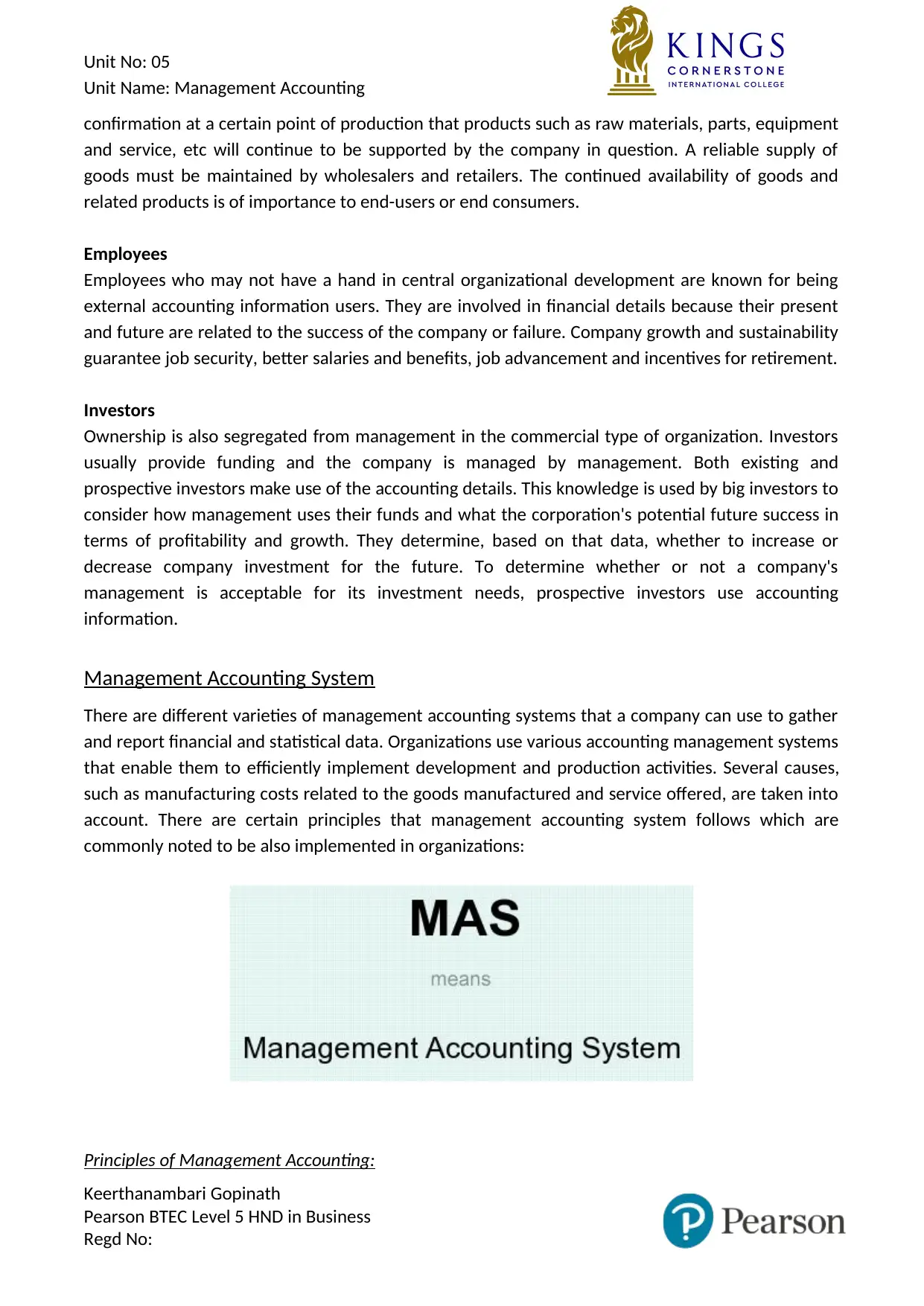
Unit No: 05
Unit Name: Management Accounting
confirmation at a certain point of production that products such as raw materials, parts, equipment
and service, etc will continue to be supported by the company in question. A reliable supply of
goods must be maintained by wholesalers and retailers. The continued availability of goods and
related products is of importance to end-users or end consumers.
Employees
Employees who may not have a hand in central organizational development are known for being
external accounting information users. They are involved in financial details because their present
and future are related to the success of the company or failure. Company growth and sustainability
guarantee job security, better salaries and benefits, job advancement and incentives for retirement.
Investors
Ownership is also segregated from management in the commercial type of organization. Investors
usually provide funding and the company is managed by management. Both existing and
prospective investors make use of the accounting details. This knowledge is used by big investors to
consider how management uses their funds and what the corporation's potential future success in
terms of profitability and growth. They determine, based on that data, whether to increase or
decrease company investment for the future. To determine whether or not a company's
management is acceptable for its investment needs, prospective investors use accounting
information.
Management Accounting System
There are different varieties of management accounting systems that a company can use to gather
and report financial and statistical data. Organizations use various accounting management systems
that enable them to efficiently implement development and production activities. Several causes,
such as manufacturing costs related to the goods manufactured and service offered, are taken into
account. There are certain principles that management accounting system follows which are
commonly noted to be also implemented in organizations:
Principles of Management Accounting:
Keerthanambari Gopinath
Pearson BTEC Level 5 HND in Business
Regd No:
Unit Name: Management Accounting
confirmation at a certain point of production that products such as raw materials, parts, equipment
and service, etc will continue to be supported by the company in question. A reliable supply of
goods must be maintained by wholesalers and retailers. The continued availability of goods and
related products is of importance to end-users or end consumers.
Employees
Employees who may not have a hand in central organizational development are known for being
external accounting information users. They are involved in financial details because their present
and future are related to the success of the company or failure. Company growth and sustainability
guarantee job security, better salaries and benefits, job advancement and incentives for retirement.
Investors
Ownership is also segregated from management in the commercial type of organization. Investors
usually provide funding and the company is managed by management. Both existing and
prospective investors make use of the accounting details. This knowledge is used by big investors to
consider how management uses their funds and what the corporation's potential future success in
terms of profitability and growth. They determine, based on that data, whether to increase or
decrease company investment for the future. To determine whether or not a company's
management is acceptable for its investment needs, prospective investors use accounting
information.
Management Accounting System
There are different varieties of management accounting systems that a company can use to gather
and report financial and statistical data. Organizations use various accounting management systems
that enable them to efficiently implement development and production activities. Several causes,
such as manufacturing costs related to the goods manufactured and service offered, are taken into
account. There are certain principles that management accounting system follows which are
commonly noted to be also implemented in organizations:
Principles of Management Accounting:
Keerthanambari Gopinath
Pearson BTEC Level 5 HND in Business
Regd No:
Paraphrase This Document
Need a fresh take? Get an instant paraphrase of this document with our AI Paraphraser
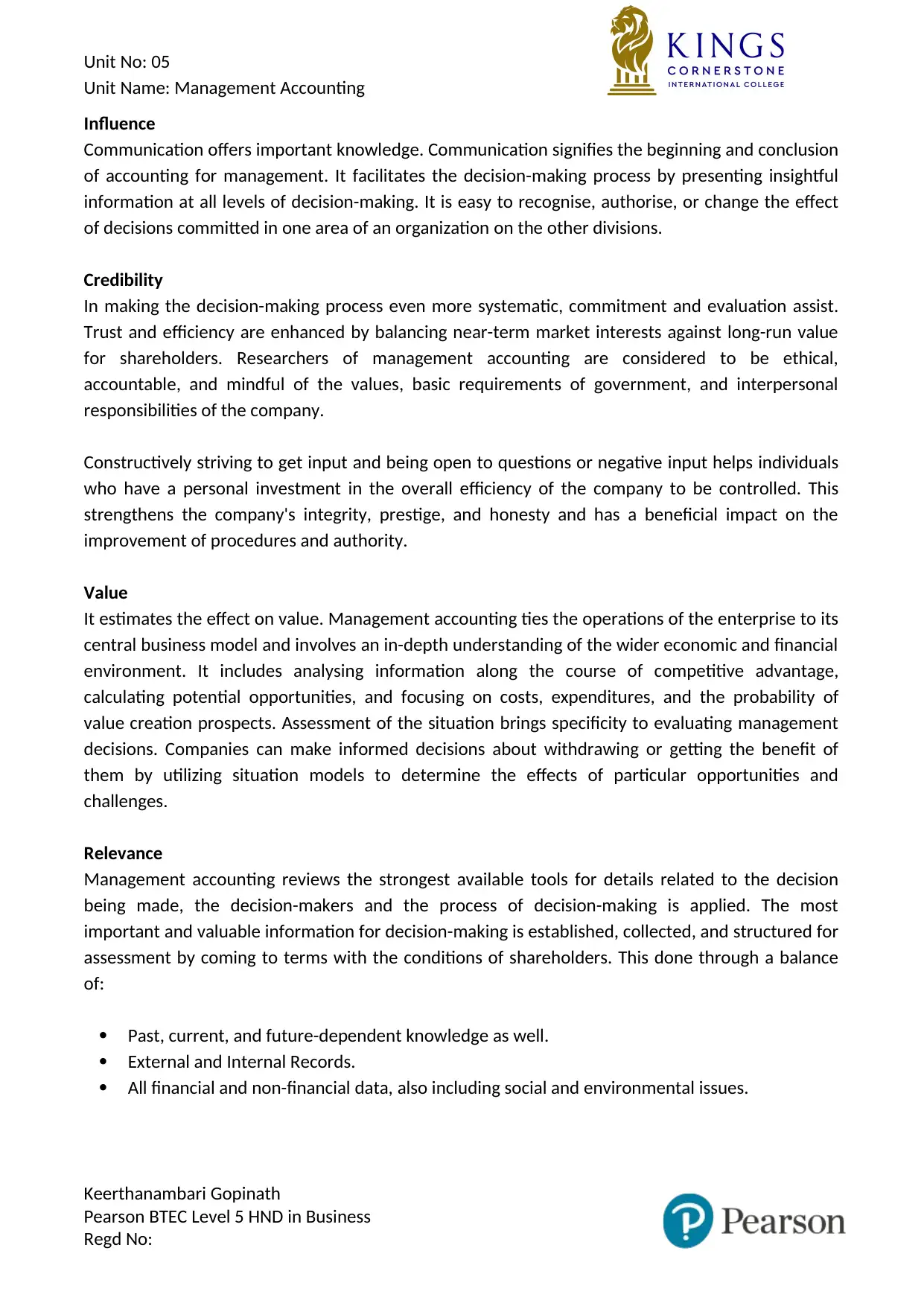
Unit No: 05
Unit Name: Management Accounting
Influence
Communication offers important knowledge. Communication signifies the beginning and conclusion
of accounting for management. It facilitates the decision-making process by presenting insightful
information at all levels of decision-making. It is easy to recognise, authorise, or change the effect
of decisions committed in one area of an organization on the other divisions.
Credibility
In making the decision-making process even more systematic, commitment and evaluation assist.
Trust and efficiency are enhanced by balancing near-term market interests against long-run value
for shareholders. Researchers of management accounting are considered to be ethical,
accountable, and mindful of the values, basic requirements of government, and interpersonal
responsibilities of the company.
Constructively striving to get input and being open to questions or negative input helps individuals
who have a personal investment in the overall efficiency of the company to be controlled. This
strengthens the company's integrity, prestige, and honesty and has a beneficial impact on the
improvement of procedures and authority.
Value
It estimates the effect on value. Management accounting ties the operations of the enterprise to its
central business model and involves an in-depth understanding of the wider economic and financial
environment. It includes analysing information along the course of competitive advantage,
calculating potential opportunities, and focusing on costs, expenditures, and the probability of
value creation prospects. Assessment of the situation brings specificity to evaluating management
decisions. Companies can make informed decisions about withdrawing or getting the benefit of
them by utilizing situation models to determine the effects of particular opportunities and
challenges.
Relevance
Management accounting reviews the strongest available tools for details related to the decision
being made, the decision-makers and the process of decision-making is applied. The most
important and valuable information for decision-making is established, collected, and structured for
assessment by coming to terms with the conditions of shareholders. This done through a balance
of:
Past, current, and future-dependent knowledge as well.
External and Internal Records.
All financial and non-financial data, also including social and environmental issues.
Keerthanambari Gopinath
Pearson BTEC Level 5 HND in Business
Regd No:
Unit Name: Management Accounting
Influence
Communication offers important knowledge. Communication signifies the beginning and conclusion
of accounting for management. It facilitates the decision-making process by presenting insightful
information at all levels of decision-making. It is easy to recognise, authorise, or change the effect
of decisions committed in one area of an organization on the other divisions.
Credibility
In making the decision-making process even more systematic, commitment and evaluation assist.
Trust and efficiency are enhanced by balancing near-term market interests against long-run value
for shareholders. Researchers of management accounting are considered to be ethical,
accountable, and mindful of the values, basic requirements of government, and interpersonal
responsibilities of the company.
Constructively striving to get input and being open to questions or negative input helps individuals
who have a personal investment in the overall efficiency of the company to be controlled. This
strengthens the company's integrity, prestige, and honesty and has a beneficial impact on the
improvement of procedures and authority.
Value
It estimates the effect on value. Management accounting ties the operations of the enterprise to its
central business model and involves an in-depth understanding of the wider economic and financial
environment. It includes analysing information along the course of competitive advantage,
calculating potential opportunities, and focusing on costs, expenditures, and the probability of
value creation prospects. Assessment of the situation brings specificity to evaluating management
decisions. Companies can make informed decisions about withdrawing or getting the benefit of
them by utilizing situation models to determine the effects of particular opportunities and
challenges.
Relevance
Management accounting reviews the strongest available tools for details related to the decision
being made, the decision-makers and the process of decision-making is applied. The most
important and valuable information for decision-making is established, collected, and structured for
assessment by coming to terms with the conditions of shareholders. This done through a balance
of:
Past, current, and future-dependent knowledge as well.
External and Internal Records.
All financial and non-financial data, also including social and environmental issues.
Keerthanambari Gopinath
Pearson BTEC Level 5 HND in Business
Regd No:
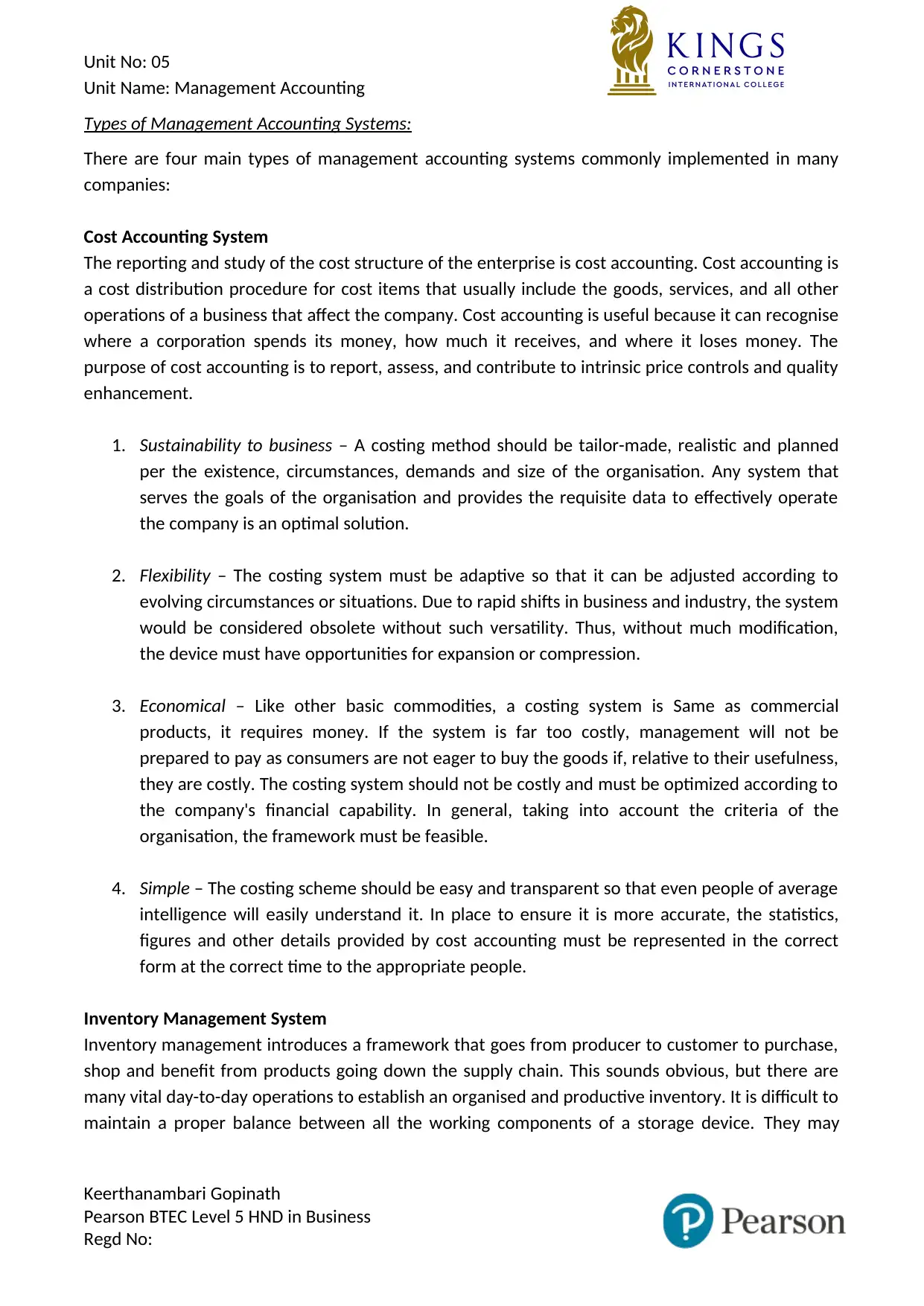
Unit No: 05
Unit Name: Management Accounting
Types of Management Accounting Systems:
There are four main types of management accounting systems commonly implemented in many
companies:
Cost Accounting System
The reporting and study of the cost structure of the enterprise is cost accounting. Cost accounting is
a cost distribution procedure for cost items that usually include the goods, services, and all other
operations of a business that affect the company. Cost accounting is useful because it can recognise
where a corporation spends its money, how much it receives, and where it loses money. The
purpose of cost accounting is to report, assess, and contribute to intrinsic price controls and quality
enhancement.
1. Sustainability to business – A costing method should be tailor-made, realistic and planned
per the existence, circumstances, demands and size of the organisation. Any system that
serves the goals of the organisation and provides the requisite data to effectively operate
the company is an optimal solution.
2. Flexibility – The costing system must be adaptive so that it can be adjusted according to
evolving circumstances or situations. Due to rapid shifts in business and industry, the system
would be considered obsolete without such versatility. Thus, without much modification,
the device must have opportunities for expansion or compression.
3. Economical – Like other basic commodities, a costing system is Same as commercial
products, it requires money. If the system is far too costly, management will not be
prepared to pay as consumers are not eager to buy the goods if, relative to their usefulness,
they are costly. The costing system should not be costly and must be optimized according to
the company's financial capability. In general, taking into account the criteria of the
organisation, the framework must be feasible.
4. Simple – The costing scheme should be easy and transparent so that even people of average
intelligence will easily understand it. In place to ensure it is more accurate, the statistics,
figures and other details provided by cost accounting must be represented in the correct
form at the correct time to the appropriate people.
Inventory Management System
Inventory management introduces a framework that goes from producer to customer to purchase,
shop and benefit from products going down the supply chain. This sounds obvious, but there are
many vital day-to-day operations to establish an organised and productive inventory. It is difficult to
maintain a proper balance between all the working components of a storage device. They may
Keerthanambari Gopinath
Pearson BTEC Level 5 HND in Business
Regd No:
Unit Name: Management Accounting
Types of Management Accounting Systems:
There are four main types of management accounting systems commonly implemented in many
companies:
Cost Accounting System
The reporting and study of the cost structure of the enterprise is cost accounting. Cost accounting is
a cost distribution procedure for cost items that usually include the goods, services, and all other
operations of a business that affect the company. Cost accounting is useful because it can recognise
where a corporation spends its money, how much it receives, and where it loses money. The
purpose of cost accounting is to report, assess, and contribute to intrinsic price controls and quality
enhancement.
1. Sustainability to business – A costing method should be tailor-made, realistic and planned
per the existence, circumstances, demands and size of the organisation. Any system that
serves the goals of the organisation and provides the requisite data to effectively operate
the company is an optimal solution.
2. Flexibility – The costing system must be adaptive so that it can be adjusted according to
evolving circumstances or situations. Due to rapid shifts in business and industry, the system
would be considered obsolete without such versatility. Thus, without much modification,
the device must have opportunities for expansion or compression.
3. Economical – Like other basic commodities, a costing system is Same as commercial
products, it requires money. If the system is far too costly, management will not be
prepared to pay as consumers are not eager to buy the goods if, relative to their usefulness,
they are costly. The costing system should not be costly and must be optimized according to
the company's financial capability. In general, taking into account the criteria of the
organisation, the framework must be feasible.
4. Simple – The costing scheme should be easy and transparent so that even people of average
intelligence will easily understand it. In place to ensure it is more accurate, the statistics,
figures and other details provided by cost accounting must be represented in the correct
form at the correct time to the appropriate people.
Inventory Management System
Inventory management introduces a framework that goes from producer to customer to purchase,
shop and benefit from products going down the supply chain. This sounds obvious, but there are
many vital day-to-day operations to establish an organised and productive inventory. It is difficult to
maintain a proper balance between all the working components of a storage device. They may
Keerthanambari Gopinath
Pearson BTEC Level 5 HND in Business
Regd No:
⊘ This is a preview!⊘
Do you want full access?
Subscribe today to unlock all pages.

Trusted by 1+ million students worldwide
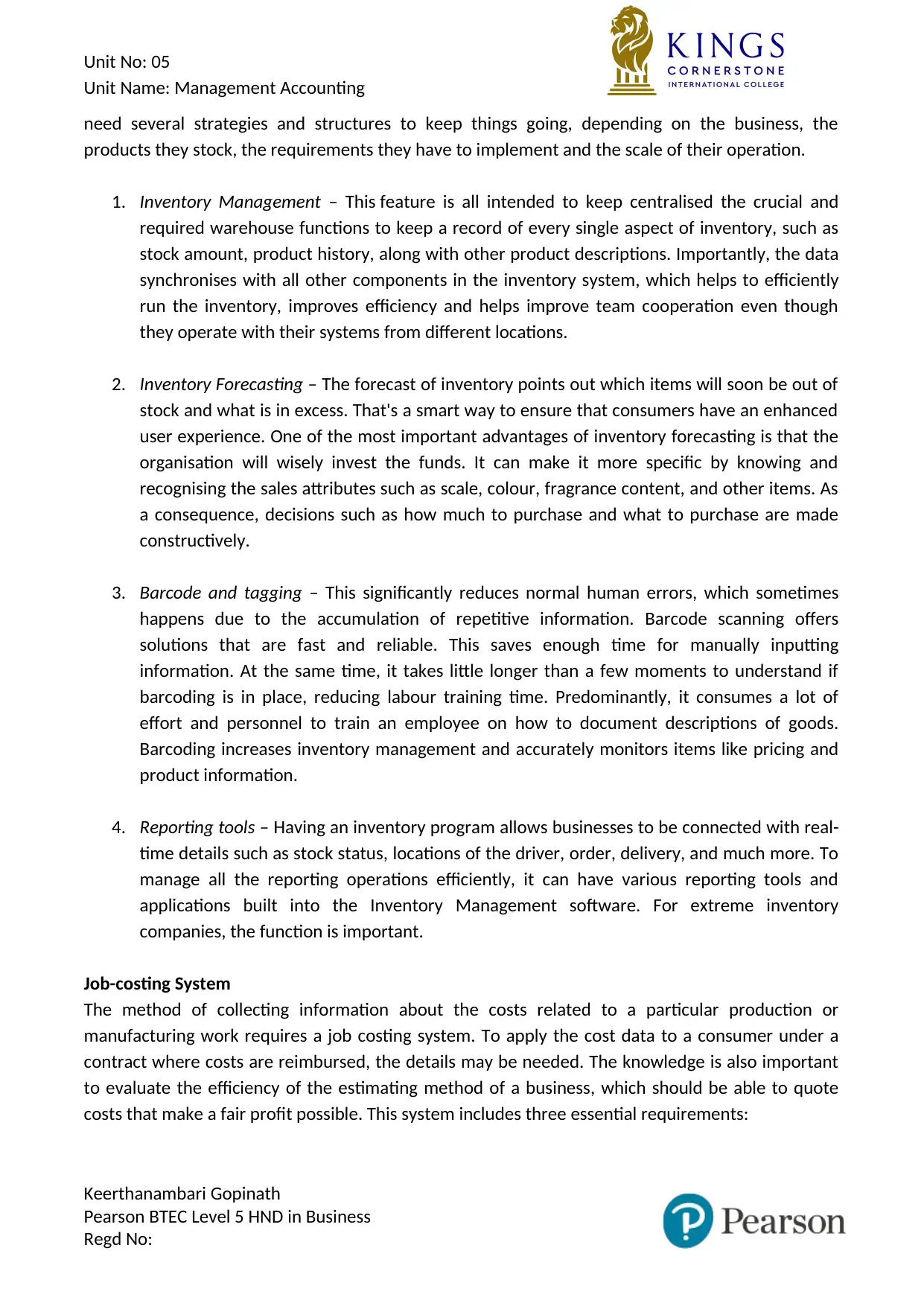
Unit No: 05
Unit Name: Management Accounting
need several strategies and structures to keep things going, depending on the business, the
products they stock, the requirements they have to implement and the scale of their operation.
1. Inventory Management – This feature is all intended to keep centralised the crucial and
required warehouse functions to keep a record of every single aspect of inventory, such as
stock amount, product history, along with other product descriptions. Importantly, the data
synchronises with all other components in the inventory system, which helps to efficiently
run the inventory, improves efficiency and helps improve team cooperation even though
they operate with their systems from different locations.
2. Inventory Forecasting – The forecast of inventory points out which items will soon be out of
stock and what is in excess. That's a smart way to ensure that consumers have an enhanced
user experience. One of the most important advantages of inventory forecasting is that the
organisation will wisely invest the funds. It can make it more specific by knowing and
recognising the sales attributes such as scale, colour, fragrance content, and other items. As
a consequence, decisions such as how much to purchase and what to purchase are made
constructively.
3. Barcode and tagging – This significantly reduces normal human errors, which sometimes
happens due to the accumulation of repetitive information. Barcode scanning offers
solutions that are fast and reliable. This saves enough time for manually inputting
information. At the same time, it takes little longer than a few moments to understand if
barcoding is in place, reducing labour training time. Predominantly, it consumes a lot of
effort and personnel to train an employee on how to document descriptions of goods.
Barcoding increases inventory management and accurately monitors items like pricing and
product information.
4. Reporting tools – Having an inventory program allows businesses to be connected with real-
time details such as stock status, locations of the driver, order, delivery, and much more. To
manage all the reporting operations efficiently, it can have various reporting tools and
applications built into the Inventory Management software. For extreme inventory
companies, the function is important.
Job-costing System
The method of collecting information about the costs related to a particular production or
manufacturing work requires a job costing system. To apply the cost data to a consumer under a
contract where costs are reimbursed, the details may be needed. The knowledge is also important
to evaluate the efficiency of the estimating method of a business, which should be able to quote
costs that make a fair profit possible. This system includes three essential requirements:
Keerthanambari Gopinath
Pearson BTEC Level 5 HND in Business
Regd No:
Unit Name: Management Accounting
need several strategies and structures to keep things going, depending on the business, the
products they stock, the requirements they have to implement and the scale of their operation.
1. Inventory Management – This feature is all intended to keep centralised the crucial and
required warehouse functions to keep a record of every single aspect of inventory, such as
stock amount, product history, along with other product descriptions. Importantly, the data
synchronises with all other components in the inventory system, which helps to efficiently
run the inventory, improves efficiency and helps improve team cooperation even though
they operate with their systems from different locations.
2. Inventory Forecasting – The forecast of inventory points out which items will soon be out of
stock and what is in excess. That's a smart way to ensure that consumers have an enhanced
user experience. One of the most important advantages of inventory forecasting is that the
organisation will wisely invest the funds. It can make it more specific by knowing and
recognising the sales attributes such as scale, colour, fragrance content, and other items. As
a consequence, decisions such as how much to purchase and what to purchase are made
constructively.
3. Barcode and tagging – This significantly reduces normal human errors, which sometimes
happens due to the accumulation of repetitive information. Barcode scanning offers
solutions that are fast and reliable. This saves enough time for manually inputting
information. At the same time, it takes little longer than a few moments to understand if
barcoding is in place, reducing labour training time. Predominantly, it consumes a lot of
effort and personnel to train an employee on how to document descriptions of goods.
Barcoding increases inventory management and accurately monitors items like pricing and
product information.
4. Reporting tools – Having an inventory program allows businesses to be connected with real-
time details such as stock status, locations of the driver, order, delivery, and much more. To
manage all the reporting operations efficiently, it can have various reporting tools and
applications built into the Inventory Management software. For extreme inventory
companies, the function is important.
Job-costing System
The method of collecting information about the costs related to a particular production or
manufacturing work requires a job costing system. To apply the cost data to a consumer under a
contract where costs are reimbursed, the details may be needed. The knowledge is also important
to evaluate the efficiency of the estimating method of a business, which should be able to quote
costs that make a fair profit possible. This system includes three essential requirements:
Keerthanambari Gopinath
Pearson BTEC Level 5 HND in Business
Regd No:
Paraphrase This Document
Need a fresh take? Get an instant paraphrase of this document with our AI Paraphraser
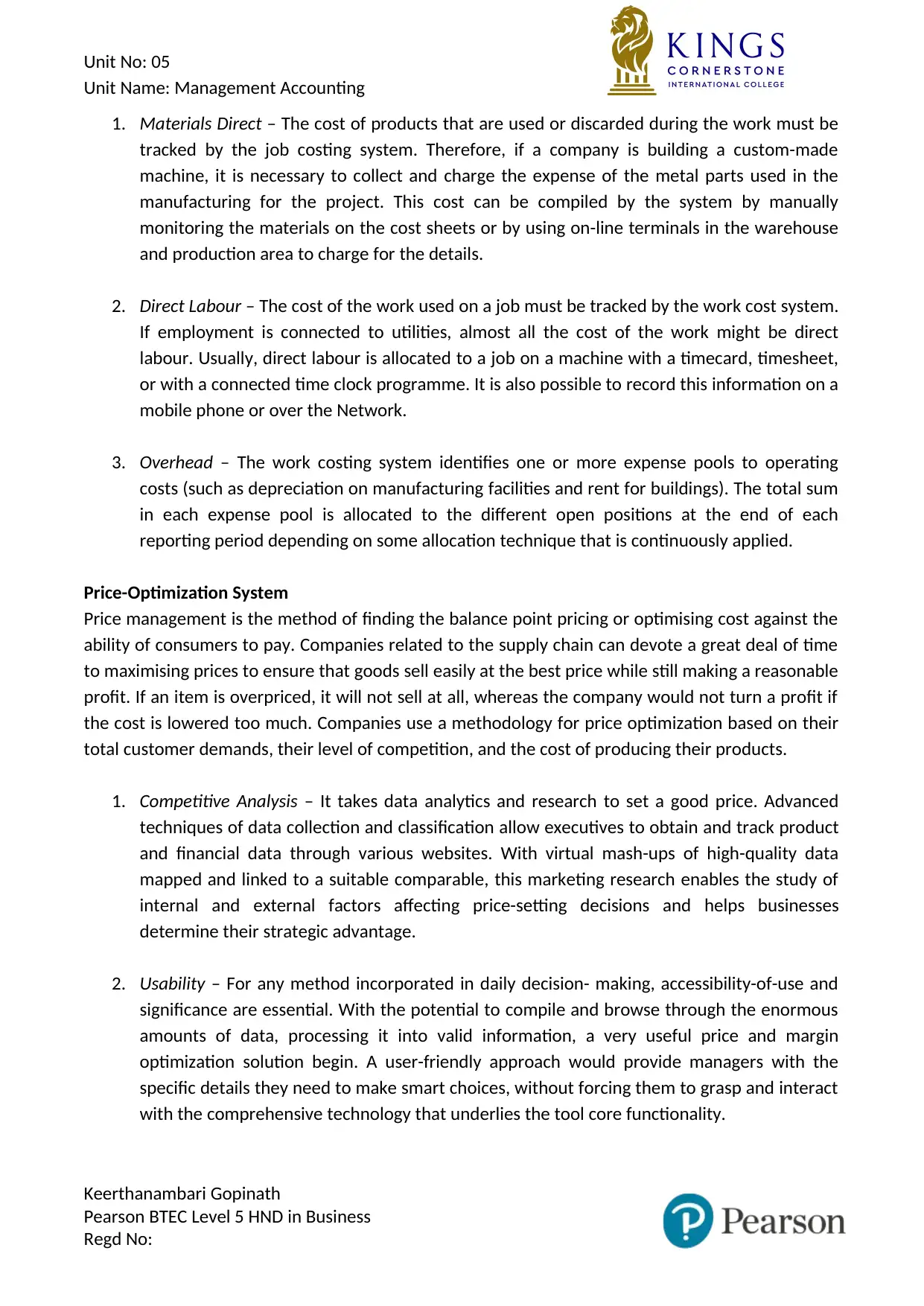
Unit No: 05
Unit Name: Management Accounting
1. Materials Direct – The cost of products that are used or discarded during the work must be
tracked by the job costing system. Therefore, if a company is building a custom-made
machine, it is necessary to collect and charge the expense of the metal parts used in the
manufacturing for the project. This cost can be compiled by the system by manually
monitoring the materials on the cost sheets or by using on-line terminals in the warehouse
and production area to charge for the details.
2. Direct Labour – The cost of the work used on a job must be tracked by the work cost system.
If employment is connected to utilities, almost all the cost of the work might be direct
labour. Usually, direct labour is allocated to a job on a machine with a timecard, timesheet,
or with a connected time clock programme. It is also possible to record this information on a
mobile phone or over the Network.
3. Overhead – The work costing system identifies one or more expense pools to operating
costs (such as depreciation on manufacturing facilities and rent for buildings). The total sum
in each expense pool is allocated to the different open positions at the end of each
reporting period depending on some allocation technique that is continuously applied.
Price-Optimization System
Price management is the method of finding the balance point pricing or optimising cost against the
ability of consumers to pay. Companies related to the supply chain can devote a great deal of time
to maximising prices to ensure that goods sell easily at the best price while still making a reasonable
profit. If an item is overpriced, it will not sell at all, whereas the company would not turn a profit if
the cost is lowered too much. Companies use a methodology for price optimization based on their
total customer demands, their level of competition, and the cost of producing their products.
1. Competitive Analysis – It takes data analytics and research to set a good price. Advanced
techniques of data collection and classification allow executives to obtain and track product
and financial data through various websites. With virtual mash-ups of high-quality data
mapped and linked to a suitable comparable, this marketing research enables the study of
internal and external factors affecting price-setting decisions and helps businesses
determine their strategic advantage.
2. Usability – For any method incorporated in daily decision- making, accessibility-of-use and
significance are essential. With the potential to compile and browse through the enormous
amounts of data, processing it into valid information, a very useful price and margin
optimization solution begin. A user-friendly approach would provide managers with the
specific details they need to make smart choices, without forcing them to grasp and interact
with the comprehensive technology that underlies the tool core functionality.
Keerthanambari Gopinath
Pearson BTEC Level 5 HND in Business
Regd No:
Unit Name: Management Accounting
1. Materials Direct – The cost of products that are used or discarded during the work must be
tracked by the job costing system. Therefore, if a company is building a custom-made
machine, it is necessary to collect and charge the expense of the metal parts used in the
manufacturing for the project. This cost can be compiled by the system by manually
monitoring the materials on the cost sheets or by using on-line terminals in the warehouse
and production area to charge for the details.
2. Direct Labour – The cost of the work used on a job must be tracked by the work cost system.
If employment is connected to utilities, almost all the cost of the work might be direct
labour. Usually, direct labour is allocated to a job on a machine with a timecard, timesheet,
or with a connected time clock programme. It is also possible to record this information on a
mobile phone or over the Network.
3. Overhead – The work costing system identifies one or more expense pools to operating
costs (such as depreciation on manufacturing facilities and rent for buildings). The total sum
in each expense pool is allocated to the different open positions at the end of each
reporting period depending on some allocation technique that is continuously applied.
Price-Optimization System
Price management is the method of finding the balance point pricing or optimising cost against the
ability of consumers to pay. Companies related to the supply chain can devote a great deal of time
to maximising prices to ensure that goods sell easily at the best price while still making a reasonable
profit. If an item is overpriced, it will not sell at all, whereas the company would not turn a profit if
the cost is lowered too much. Companies use a methodology for price optimization based on their
total customer demands, their level of competition, and the cost of producing their products.
1. Competitive Analysis – It takes data analytics and research to set a good price. Advanced
techniques of data collection and classification allow executives to obtain and track product
and financial data through various websites. With virtual mash-ups of high-quality data
mapped and linked to a suitable comparable, this marketing research enables the study of
internal and external factors affecting price-setting decisions and helps businesses
determine their strategic advantage.
2. Usability – For any method incorporated in daily decision- making, accessibility-of-use and
significance are essential. With the potential to compile and browse through the enormous
amounts of data, processing it into valid information, a very useful price and margin
optimization solution begin. A user-friendly approach would provide managers with the
specific details they need to make smart choices, without forcing them to grasp and interact
with the comprehensive technology that underlies the tool core functionality.
Keerthanambari Gopinath
Pearson BTEC Level 5 HND in Business
Regd No:
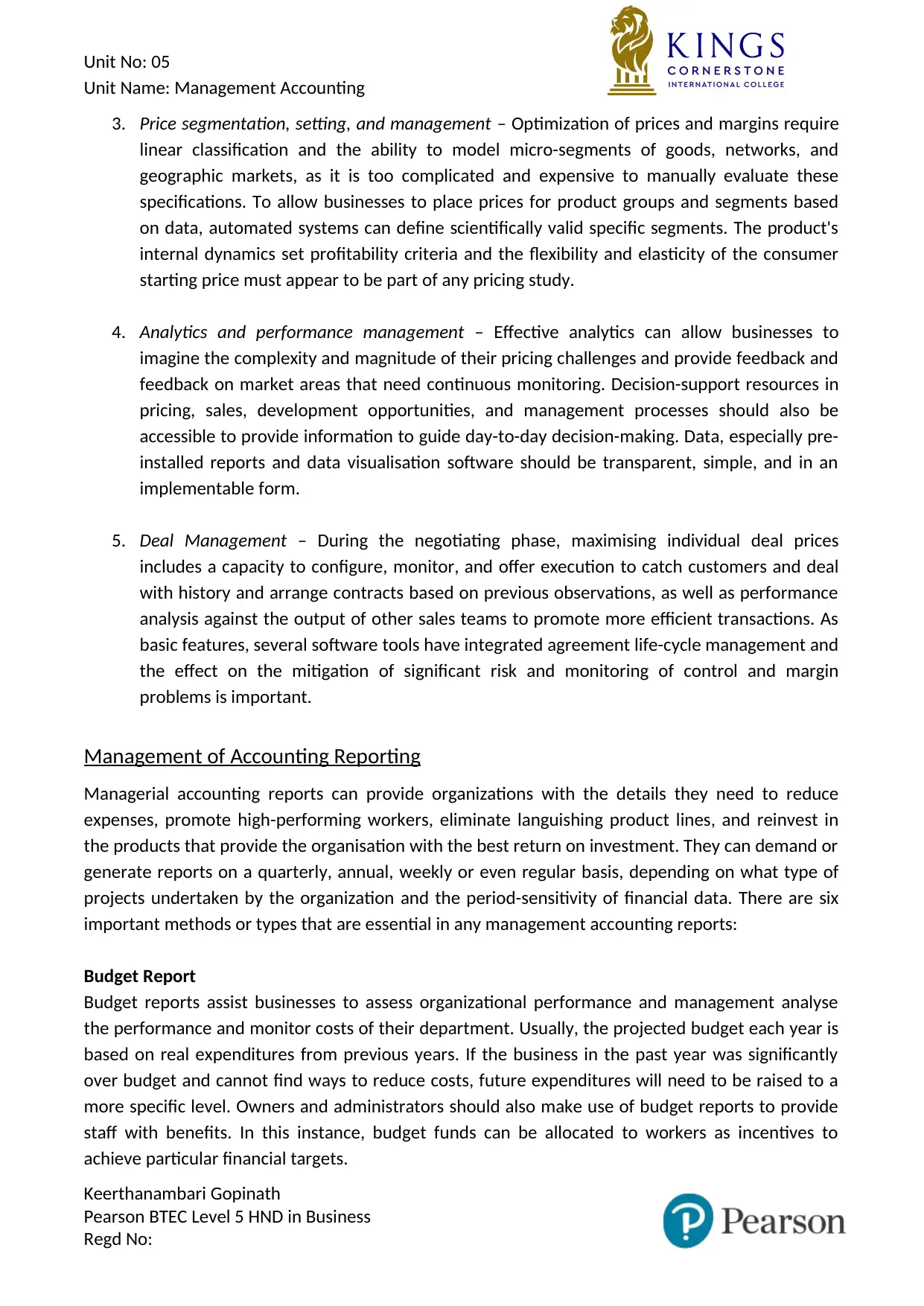
Unit No: 05
Unit Name: Management Accounting
3. Price segmentation, setting, and management – Optimization of prices and margins require
linear classification and the ability to model micro-segments of goods, networks, and
geographic markets, as it is too complicated and expensive to manually evaluate these
specifications. To allow businesses to place prices for product groups and segments based
on data, automated systems can define scientifically valid specific segments. The product's
internal dynamics set profitability criteria and the flexibility and elasticity of the consumer
starting price must appear to be part of any pricing study.
4. Analytics and performance management – Effective analytics can allow businesses to
imagine the complexity and magnitude of their pricing challenges and provide feedback and
feedback on market areas that need continuous monitoring. Decision-support resources in
pricing, sales, development opportunities, and management processes should also be
accessible to provide information to guide day-to-day decision-making. Data, especially pre-
installed reports and data visualisation software should be transparent, simple, and in an
implementable form.
5. Deal Management – During the negotiating phase, maximising individual deal prices
includes a capacity to configure, monitor, and offer execution to catch customers and deal
with history and arrange contracts based on previous observations, as well as performance
analysis against the output of other sales teams to promote more efficient transactions. As
basic features, several software tools have integrated agreement life-cycle management and
the effect on the mitigation of significant risk and monitoring of control and margin
problems is important.
Management of Accounting Reporting
Managerial accounting reports can provide organizations with the details they need to reduce
expenses, promote high-performing workers, eliminate languishing product lines, and reinvest in
the products that provide the organisation with the best return on investment. They can demand or
generate reports on a quarterly, annual, weekly or even regular basis, depending on what type of
projects undertaken by the organization and the period-sensitivity of financial data. There are six
important methods or types that are essential in any management accounting reports:
Budget Report
Budget reports assist businesses to assess organizational performance and management analyse
the performance and monitor costs of their department. Usually, the projected budget each year is
based on real expenditures from previous years. If the business in the past year was significantly
over budget and cannot find ways to reduce costs, future expenditures will need to be raised to a
more specific level. Owners and administrators should also make use of budget reports to provide
staff with benefits. In this instance, budget funds can be allocated to workers as incentives to
achieve particular financial targets.
Keerthanambari Gopinath
Pearson BTEC Level 5 HND in Business
Regd No:
Unit Name: Management Accounting
3. Price segmentation, setting, and management – Optimization of prices and margins require
linear classification and the ability to model micro-segments of goods, networks, and
geographic markets, as it is too complicated and expensive to manually evaluate these
specifications. To allow businesses to place prices for product groups and segments based
on data, automated systems can define scientifically valid specific segments. The product's
internal dynamics set profitability criteria and the flexibility and elasticity of the consumer
starting price must appear to be part of any pricing study.
4. Analytics and performance management – Effective analytics can allow businesses to
imagine the complexity and magnitude of their pricing challenges and provide feedback and
feedback on market areas that need continuous monitoring. Decision-support resources in
pricing, sales, development opportunities, and management processes should also be
accessible to provide information to guide day-to-day decision-making. Data, especially pre-
installed reports and data visualisation software should be transparent, simple, and in an
implementable form.
5. Deal Management – During the negotiating phase, maximising individual deal prices
includes a capacity to configure, monitor, and offer execution to catch customers and deal
with history and arrange contracts based on previous observations, as well as performance
analysis against the output of other sales teams to promote more efficient transactions. As
basic features, several software tools have integrated agreement life-cycle management and
the effect on the mitigation of significant risk and monitoring of control and margin
problems is important.
Management of Accounting Reporting
Managerial accounting reports can provide organizations with the details they need to reduce
expenses, promote high-performing workers, eliminate languishing product lines, and reinvest in
the products that provide the organisation with the best return on investment. They can demand or
generate reports on a quarterly, annual, weekly or even regular basis, depending on what type of
projects undertaken by the organization and the period-sensitivity of financial data. There are six
important methods or types that are essential in any management accounting reports:
Budget Report
Budget reports assist businesses to assess organizational performance and management analyse
the performance and monitor costs of their department. Usually, the projected budget each year is
based on real expenditures from previous years. If the business in the past year was significantly
over budget and cannot find ways to reduce costs, future expenditures will need to be raised to a
more specific level. Owners and administrators should also make use of budget reports to provide
staff with benefits. In this instance, budget funds can be allocated to workers as incentives to
achieve particular financial targets.
Keerthanambari Gopinath
Pearson BTEC Level 5 HND in Business
Regd No:
⊘ This is a preview!⊘
Do you want full access?
Subscribe today to unlock all pages.

Trusted by 1+ million students worldwide
1 out of 47
Related Documents
Your All-in-One AI-Powered Toolkit for Academic Success.
+13062052269
info@desklib.com
Available 24*7 on WhatsApp / Email
![[object Object]](/_next/static/media/star-bottom.7253800d.svg)
Unlock your academic potential
Copyright © 2020–2025 A2Z Services. All Rights Reserved. Developed and managed by ZUCOL.





